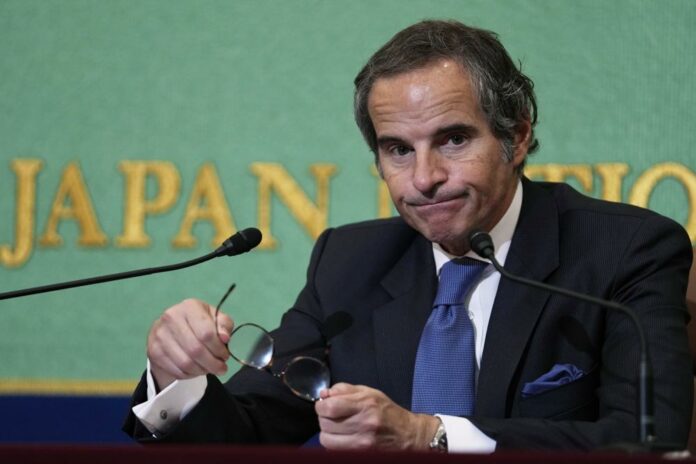
The head of the U.N.’s nuclear watchdog agency said Thursday that Iran is removing 27 surveillance cameras from nuclear sites in the country, raising the risk of its inspectors being unable to track Tehran’s advances as it enriches closer than ever to weapons-grade levels.
Rafael Mariano Grossi, the director-general of the International Atomic Energy Agency, made the comments at a suddenly called news conference in Vienna, standing next to an example of the cameras installed across Iran.
Grossi said the move poses a “serious challenge” to its efforts, warning that in three to four weeks, it would be unable to maintain a “continuity of knowledge” about Iran’s program.
“This would be a fatal blow” to negotiations over Iran’s tattered nuclear deal with world powers, Grossi said.
”When we lose this, then it’s anybody’s guess,” he added.
Iran did not immediately acknowledge it was removing the cameras, though it threatened Wednesday to take more steps amid a years long crisis that threatens to widen into further attacks across the Mideast.
Grossi said that would leave “40-something” cameras still in Iran. The sites that would see cameras removed include its underground Natanz nuclear enrichment facility, as well as its facility in Isfahan, Grossi said.
“We are in a very tense situation with the negotiations over the (nuclear deal) at a low ebb,” Grossi added. “Now we are adding this to the picture; as you can see it’s not a very nice one.”
On Wednesday, Iran said it shut off two devices the IAEA uses to monitor enrichment at Natanz. Grossi acknowledged that, saying that among the devices being removed was the Online Enrichment Monitor and flowmeter. Those watch the enrichment of uranium gas through piping at enrichment facilities.
Iran’s decision comes as the IAEA’s board censured Tehran over what the agency calls the Islamic Republic’s failure to provide “credible information” over man-made nuclear material found at three undeclared sites in the country.
The IAEA earlier Thursday said Grossi told members that Iran informed the agency that it planned to install two new cascades of the IR-6 at Natanz. A cascade is a series of centrifuges hooked together to rapidly spin uranium gas to enrich it.
An IR-6 centrifuge spins uranium 10 times as fast as the first-generation centrifuges that Iran was once limited to under its nuclear deal with world powers. As of February, Iran already had been spinning a cascade of IR-6s at its underground facility at Fordo, according to the IAEA.
Iran earlier said it planned to install one cascade of IR-6s at Natanz. The IAEA said it “verified” the ongoing installation of that cascade Monday, while the newly promised two new cascades had yet to begin.
Iran and world powers agreed in 2015 to the nuclear deal, which saw Tehran drastically limit its enrichment of uranium in exchange for the lifting of economic sanctions. In 2018, then-President Donald Trump unilaterally withdrew America from the accord, raising tensions across the wider Middle East and sparking a series of attacks and incidents.
Talks in Vienna over Iran’s tattered nuclear deal have been stalled since April. Since the deal’s collapse, Iran runs advanced centrifuges and has a rapidly growing stockpile of enriched uranium.
Nonproliferation experts warn Iran has enriched enough up to 60% purity — a short technical step from weapons-grade levels of 90% — to make one nuclear weapon should it decide to do so.
Iran insists its program is for peaceful purposes, though U.N. experts and Western intelligence agencies say Iran had an organized military nuclear program through 2003.
Building a nuclear bomb would still take Iran more time if it pursued a weapon, analysts say, though they warn Tehran’s advances make the program more dangerous. Israel has threatened in the past that it would carry out a preemptive strike to stop Iran — and already is suspected in a series of recent killings targeting Iranian officials.
Iran already has been holding footage from IAEA surveillance cameras since February 2021 as a pressure tactic to restore the atomic accord. The Atomic Energy Organization of Iran, which runs its civilian nuclear program, published video it said showed its workers turning off both regular and backup battery power for two IAEA cameras on Wednesday.
The censure resolution at the IAEA meeting in Vienna, sponsored by Germany, France, the U.K. and U.S., passed with the support of 30 of 35 governors. Russia and China voted against, Russian ambassador Mikhail Ulyanov wrote on Twitter. India, Libya and Pakistan abstained.
After the vote, a joint statement from France, Germany, and the U.K. and the U.S. said the censure “sends an unambiguous message to Iran that it must meet its safeguards obligations and provide technically credible clarifications on outstanding safeguards issues.”
Iran’s Foreign Ministry meanwhile criticized the censure as a “political, incorrect and unconstructive action.”
An Iranian official earlier warned IAEA officials that Tehran was now considering taking “other measures” as well.
“We hope that they come to their senses and respond to Iran’s cooperation with cooperation,” said Behrouz Kamalvandi, an Iranian nuclear spokesman. “It is not acceptable that they show inappropriate behavior while Iran continues to cooperate.”
Israeli Prime Minister Naftali Bennett praised the vote as “a significant decision that exposes Iran’s true face.”
The “IAEA vote is a clear warning light to Iran: If Iran continues its activity, the leading countries must bring the matter back to the U.N. Security Council,” said Bennett, who made an unannounced trip Thursday to the United Arab Emirates.
Chinese Foreign Ministry spokesperson Zhao Lijian called the U.S. “the culprit in the Iranian nuclear crisis” and urged America to “respond positively to the legitimate concerns of the Iranian side.”
Wednesday night, a drone exploded in the northern Iraqi city of Irbil in its Kurdish region, slightly wounding three people and damaging cars and a nearby restaurant, officials said. The Kurdistan region’s directorate general of counter-terrorism alleged Thursday that the Iran-backed Kataeb Hezbollah, or Hezbollah Brigades, launched the drone.
(AP)
Source: The Yeshiva World